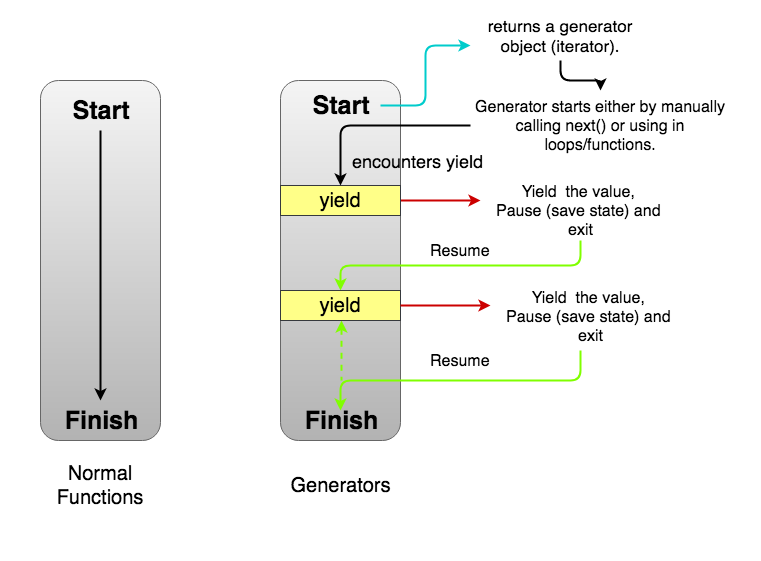es6
常量
//ES5Object.defineProperty(window, "PI2",{value: 3.1415926,writable: false,})//ES6const PI=3.1415926
var、let、const三者的区别
ECMAScript 6(简称ES6)中新增了块级作用域。块作用域由 { } 包括,if语句和for语句里面的{ }也属于块作用域。var定义变量,没有块的概念,可以跨块访问,不能跨函数访问,不初始化出现undefined,不会报错。let定义变量,只能在块作用域里访问,也不能跨函数访问,对函数外部无影响。const定义常量,只能在块作用域里访问,也不能跨函数访问,使用时必须初始化(即必须赋值)[每个const变量都必须在声明的同时进行初始化],而且不能修改。如果是对象,可以修改对象的属性let a = "hey I am outside";if(true){console.log(a);//Uncaught ReferenceError: a is not definedlet a = "hey I am inside";}变量提升这里同样抛出了一个错误,认为a没有声明,但是,如果a没有变量提升,执行到console.log时应该是输出全局作用域中的a,而不是出现错误。这里确实出现了变量提升,而我们不能够访问的原因事实上是因为let的死区(temporal dead zone)设计:当前作用域顶部到该变量声明位置中间的部分,都是该let变量的死区,在死区中,禁止访问该变量。由此,我们给出结论,let声明的变量存在变量提升, 但是由于死区我们无法在声明前访问这个变量.
js class 继承
class Animal {constructor(name){this.name = name}eat() {console.log(`${this.name} eat`)}}class Dog extends Animal {constructor(name) {super(name)this.name = name}say() {console.log(`${this.name} say`)}}const dog = new Dog('hasky')dog.say()//hasky saydog.eat()//hasky eatclass 在语法上更加贴合面向对象的写法class 实现继承更加易读、易理解本质是语法糖总结一下:static 关键字声明的是静态方法,不会被实例继承,只可以直接通过类来调用;class 没有变量提升,因此必须在定义之后才使用;constructor 为构造函数,子类构造函数中的 super 代表父类的构造函数,必须执行一次,否则新建实例时会抛错;class 用 extends 来实现继承,子类继承父类所有实例方法和属性。
模板字符串
let a = `${variable_a} some text`
解构赋值
ES6 允许按照一定方式,从数组和对象中提取值。本质上这种写法属于 模式匹配,只要等号两边的模式相同,左边的变量就会被赋予相对应的值。数组的解构赋值:let [a, b, c] = [1, 2, 3] // a:1 b:2 c:3let [a, [[b], c]] = [1, [[2], 3]] // a:1 b:2 c:3let [a, , b] = [1, 2, 3] // a:1 b:3let [a,...b] = [1, 2, 3] // a:1 b:[2, 3]let [a, b,...c] = [1] // a:1 b:undefined c:[]let [a, b = 4] = [null, undefined] // a:null b:4let [a, b = 4] = [1] // a:1 b:4let [a, b = 4] = [1, null] // a:1 b:null解构不成功,变量的值为 undefined解构可以指定默认值,如果被解构变量的对应位置没有值,即为空,或者值为 undefined,默认值才会生效。对象解构基本用法:let { a, b } = { a: 1, b: 2 } // a:1 b:2let { c } = { a: 1, b: 2 } // c:undefinedlet { c = 4 } = { a: 1, b: 2 } // c:4let { a: c } = { a: 1, b: 2 } // c:1let { a: c = 4, d: e = 5 } = { a: 1, b: 2 } // c:1 e:5let { length } = [1, 2] // length:2//多层嵌套 取值let props={person:{name: "xiaoming",// age: "18"}}let { person: {name, age="100"} } = props;解构不成功,变量的值为 undefined解构可以指定默认值,如果被解构变量严格为 undefined 或为空,默认值才会生效;如果变量名和属性名不一致,可以赋给其它名字的变量 {a:c},实际上对象解构赋值 {a} 是简写 {a:a},对象的解构赋值是先找到同名属性,再赋给对应的变量,真正被赋值的是后者。
块级作用域
let obj = { foo: "aaa", bar: "bbb" };for (var item in obj){console.log(item)}console.log(item)// have value "bar" herefor (let item in obj){console.log(item)}console.log(item)// ReferenceError: item is not defined
箭头函数
function fn() {console.log('real', this)//{a:100}var arr = [1, 2, 3]普通jsarr.map(function (item) {console.log('js',this) //windowreturn item + 1})//箭头函数arr.map(item => {console.log('js',this) //{a:100}return item + 1})}fn.call({a:100})// 箭头函数没有自己的this, 箭头函数的this总是指向词法作用域,也就是外层调用者obj// 箭头函数 并且没有自己的this,arguments,super或new.target// 箭头函数 Not suitable for call, apply and bind methods// 箭头函数表达式更适用于那些本来需要匿名函数的地方,并且它不能用作构造函数//一般方法中,this代指全局对象 window//作为对象方法调用,this代指当前对象//作为构造函数调用,this 指代new 出的对象
函数默认参数
function (a, b) {if (b == null) {b = 0}}//es6function (a, b=0) {// body...}
扩展运算符( spread )是三个点 ...
let a=[1,2]let b=[5,6]b.push(...a)console.log(b)//[ 5, 6, 1, 2 ]合并数组// ES5[1, 2].concat(more)// ES6[1, 2, ...more][...arr1, ...arr2, ...arr3]### 高阶函数中过滤掉不想要的属性...render() {const { unacceptedProp, byebye, ...acceptedProps } = this.props;return <WrappedComponent {...acceptedProps} />}
以前如果我们想将数组元素迭代为函数参数使用,一般使用Function.prototype.apply的方式。
function myFunction(x, y, z) {console.log(x+""+y+""+z);}let args = [0, 1, 2]myFunction.apply(null, args)
有了展开语法,我们可以这样写
function myFunction(x, y, z) {console.log(x+""+y+""+z);}myFunction(...args)//说明...arr返回的并不是一个数组,而是各个数组的值。只有[...arr]才是一个数组,所以...arr可以用来对方法进行传值
Generator
The function* declaration (function keyword followed by an asterisk) defines a generator function, which returns a Generator object.
function* generator(i) {yield i;yield i + 10;}const gen = generator(10);console.log(gen.next().value);// expected output: 10console.log(gen.next().value);// expected output: 20console.log(gen.next());// { value: undefined, done: true }//Calling a generator function does not execute its body immediately; an iterator object for the function is returned instead.
A return statement in a generator, when executed, will make the generator finish (i.e. the done property of the object returned by it will be set to true)
function* yieldAndReturn() {yield "Y";return "R";yield "unreachable";}var gen = yieldAndReturn()console.log(gen.next()); // { value: "Y", done: false }console.log(gen.next()); // { value: "R", done: true }console.log(gen.next()); // { value: undefined, done: true }

dva 框架 effect
app.model({namespace: 'todos',effects: {*addRemote({ payload: todo },{ put, call, select }){yield call(addTodo, todo);yield put({ type: 'add', payload: todo });},},});// put 用于触发action。// call 用于调用异步逻辑,支持promise// select 用于从state里获取数据const todos = yield select(state => state.todos);